Complete IT Networking and Communication Assignment 2 Solution
VerifiedAdded on 2023/04/25
|6
|913
|420
Homework Assignment
AI Summary
This document presents a comprehensive solution to an IT Networking and Communication assignment. The solution addresses key concepts including classful and classless addressing, IPv4 and IPv6, subnetting, and NAT. It explains the differences between connection-oriented and connectionless services, fragmentation, and various transition strategies from IPv4 to IPv6. The assignment also covers address mapping protocols like ARP, ICMP, autonomous systems, and routing protocols such as RIP, OSPF, and BGP. The solution provides detailed answers to each question, offering a thorough understanding of the fundamental principles of IT networking and communication.
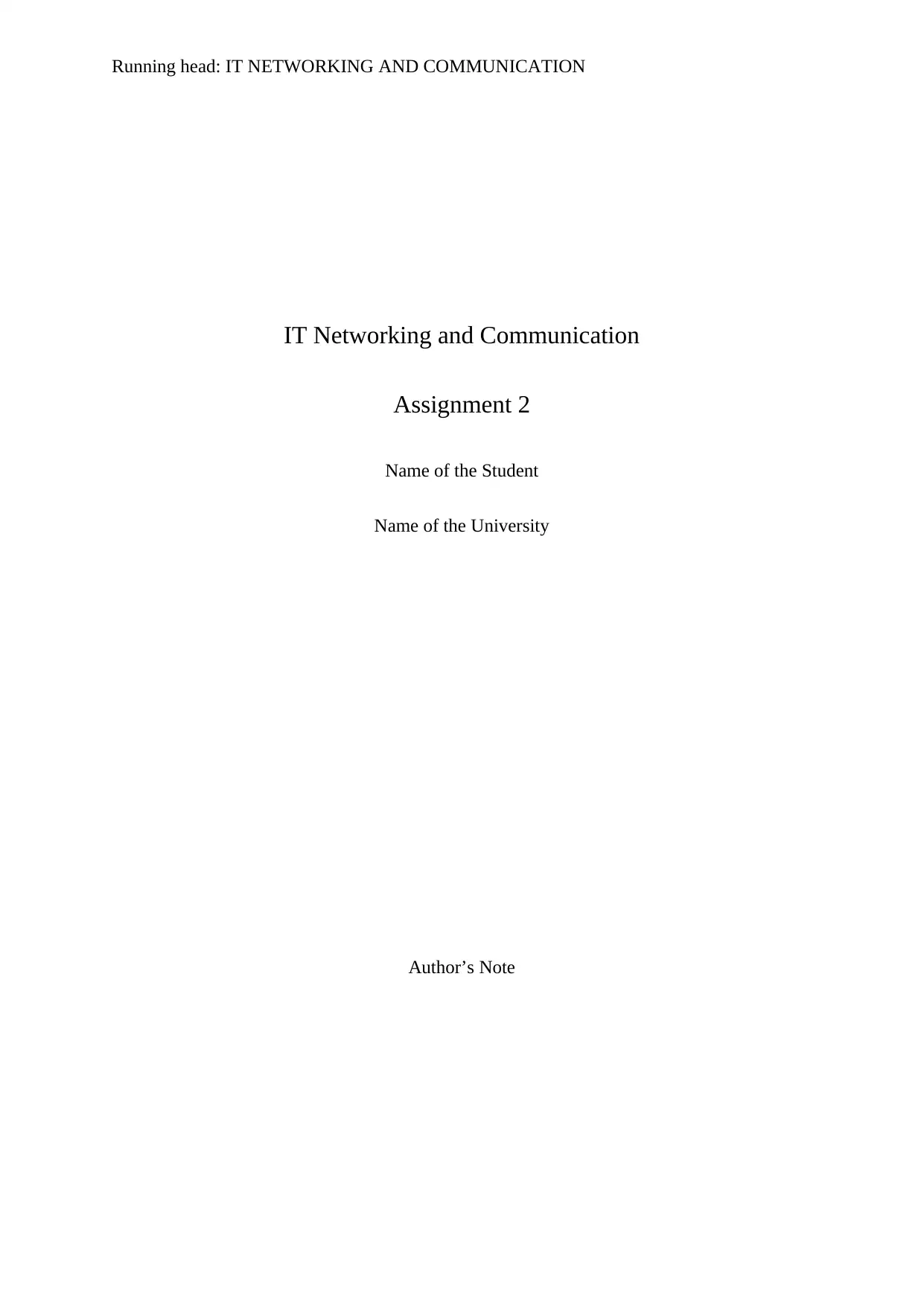
Running head: IT NETWORKING AND COMMUNICATION
IT Networking and Communication
Assignment 2
Name of the Student
Name of the University
Author’s Note
IT Networking and Communication
Assignment 2
Name of the Student
Name of the University
Author’s Note
Paraphrase This Document
Need a fresh take? Get an instant paraphrase of this document with our AI Paraphraser
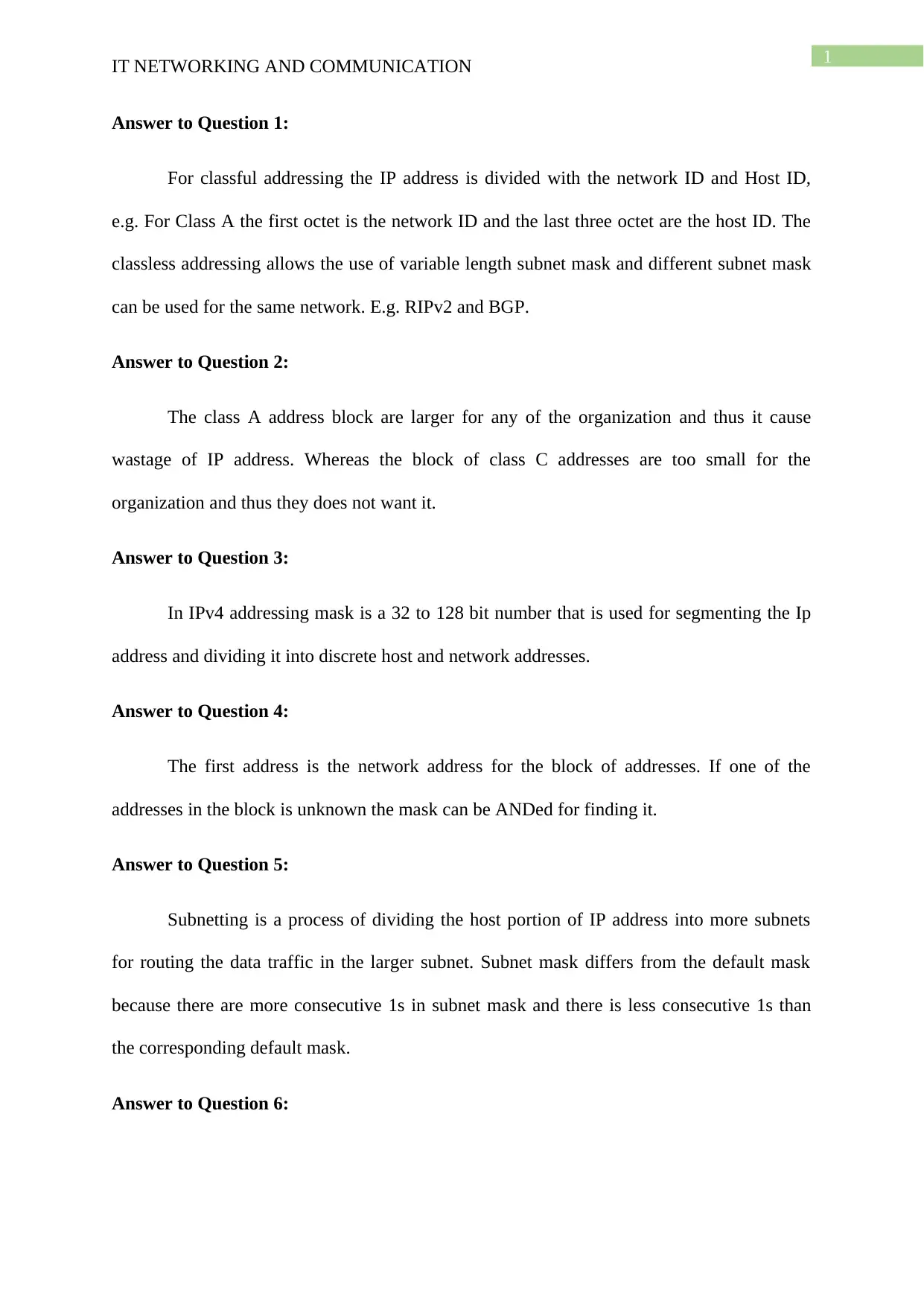
1
IT NETWORKING AND COMMUNICATION
Answer to Question 1:
For classful addressing the IP address is divided with the network ID and Host ID,
e.g. For Class A the first octet is the network ID and the last three octet are the host ID. The
classless addressing allows the use of variable length subnet mask and different subnet mask
can be used for the same network. E.g. RIPv2 and BGP.
Answer to Question 2:
The class A address block are larger for any of the organization and thus it cause
wastage of IP address. Whereas the block of class C addresses are too small for the
organization and thus they does not want it.
Answer to Question 3:
In IPv4 addressing mask is a 32 to 128 bit number that is used for segmenting the Ip
address and dividing it into discrete host and network addresses.
Answer to Question 4:
The first address is the network address for the block of addresses. If one of the
addresses in the block is unknown the mask can be ANDed for finding it.
Answer to Question 5:
Subnetting is a process of dividing the host portion of IP address into more subnets
for routing the data traffic in the larger subnet. Subnet mask differs from the default mask
because there are more consecutive 1s in subnet mask and there is less consecutive 1s than
the corresponding default mask.
Answer to Question 6:
IT NETWORKING AND COMMUNICATION
Answer to Question 1:
For classful addressing the IP address is divided with the network ID and Host ID,
e.g. For Class A the first octet is the network ID and the last three octet are the host ID. The
classless addressing allows the use of variable length subnet mask and different subnet mask
can be used for the same network. E.g. RIPv2 and BGP.
Answer to Question 2:
The class A address block are larger for any of the organization and thus it cause
wastage of IP address. Whereas the block of class C addresses are too small for the
organization and thus they does not want it.
Answer to Question 3:
In IPv4 addressing mask is a 32 to 128 bit number that is used for segmenting the Ip
address and dividing it into discrete host and network addresses.
Answer to Question 4:
The first address is the network address for the block of addresses. If one of the
addresses in the block is unknown the mask can be ANDed for finding it.
Answer to Question 5:
Subnetting is a process of dividing the host portion of IP address into more subnets
for routing the data traffic in the larger subnet. Subnet mask differs from the default mask
because there are more consecutive 1s in subnet mask and there is less consecutive 1s than
the corresponding default mask.
Answer to Question 6:
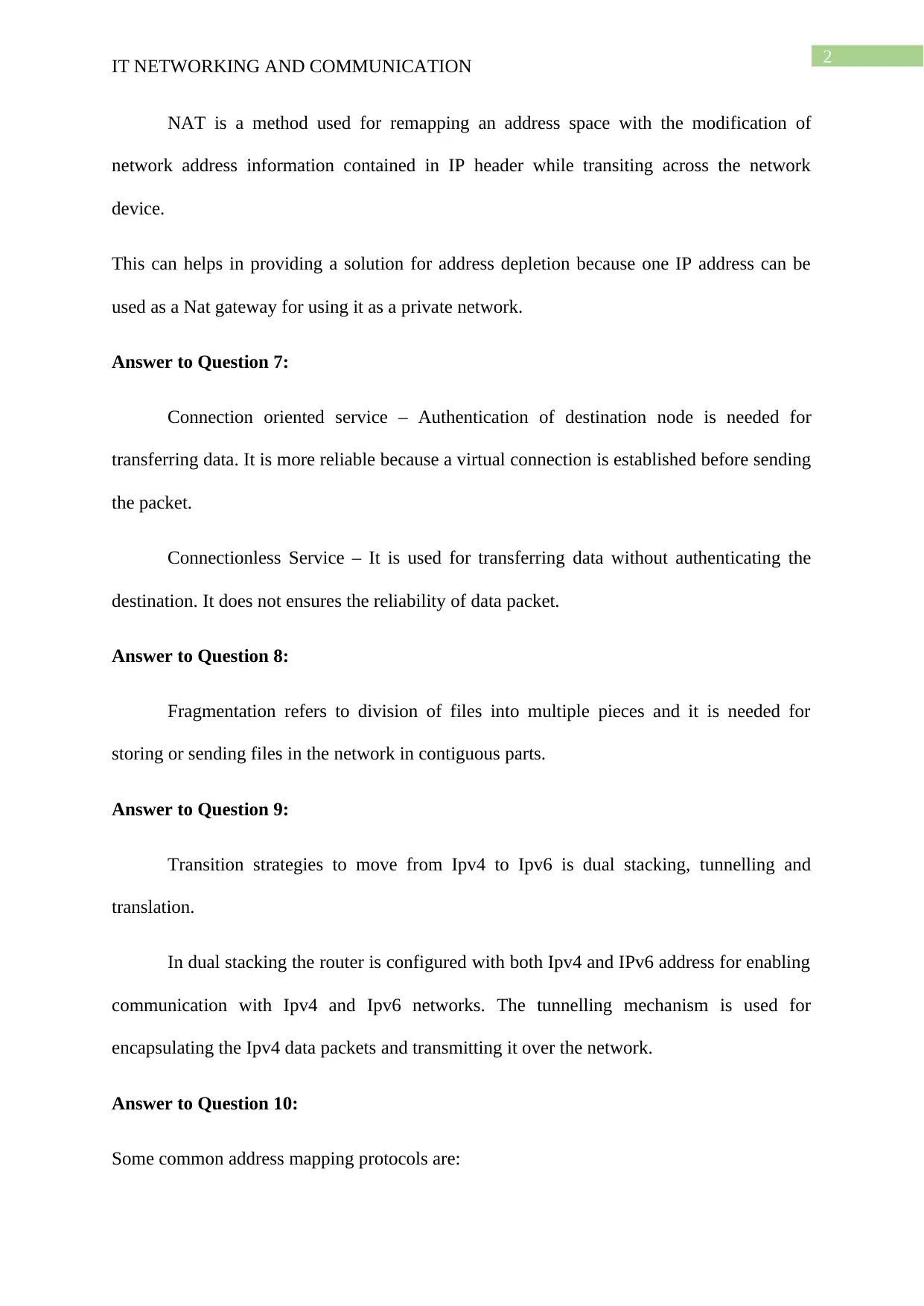
2
IT NETWORKING AND COMMUNICATION
NAT is a method used for remapping an address space with the modification of
network address information contained in IP header while transiting across the network
device.
This can helps in providing a solution for address depletion because one IP address can be
used as a Nat gateway for using it as a private network.
Answer to Question 7:
Connection oriented service – Authentication of destination node is needed for
transferring data. It is more reliable because a virtual connection is established before sending
the packet.
Connectionless Service – It is used for transferring data without authenticating the
destination. It does not ensures the reliability of data packet.
Answer to Question 8:
Fragmentation refers to division of files into multiple pieces and it is needed for
storing or sending files in the network in contiguous parts.
Answer to Question 9:
Transition strategies to move from Ipv4 to Ipv6 is dual stacking, tunnelling and
translation.
In dual stacking the router is configured with both Ipv4 and IPv6 address for enabling
communication with Ipv4 and Ipv6 networks. The tunnelling mechanism is used for
encapsulating the Ipv4 data packets and transmitting it over the network.
Answer to Question 10:
Some common address mapping protocols are:
IT NETWORKING AND COMMUNICATION
NAT is a method used for remapping an address space with the modification of
network address information contained in IP header while transiting across the network
device.
This can helps in providing a solution for address depletion because one IP address can be
used as a Nat gateway for using it as a private network.
Answer to Question 7:
Connection oriented service – Authentication of destination node is needed for
transferring data. It is more reliable because a virtual connection is established before sending
the packet.
Connectionless Service – It is used for transferring data without authenticating the
destination. It does not ensures the reliability of data packet.
Answer to Question 8:
Fragmentation refers to division of files into multiple pieces and it is needed for
storing or sending files in the network in contiguous parts.
Answer to Question 9:
Transition strategies to move from Ipv4 to Ipv6 is dual stacking, tunnelling and
translation.
In dual stacking the router is configured with both Ipv4 and IPv6 address for enabling
communication with Ipv4 and Ipv6 networks. The tunnelling mechanism is used for
encapsulating the Ipv4 data packets and transmitting it over the network.
Answer to Question 10:
Some common address mapping protocols are:
⊘ This is a preview!⊘
Do you want full access?
Subscribe today to unlock all pages.

Trusted by 1+ million students worldwide
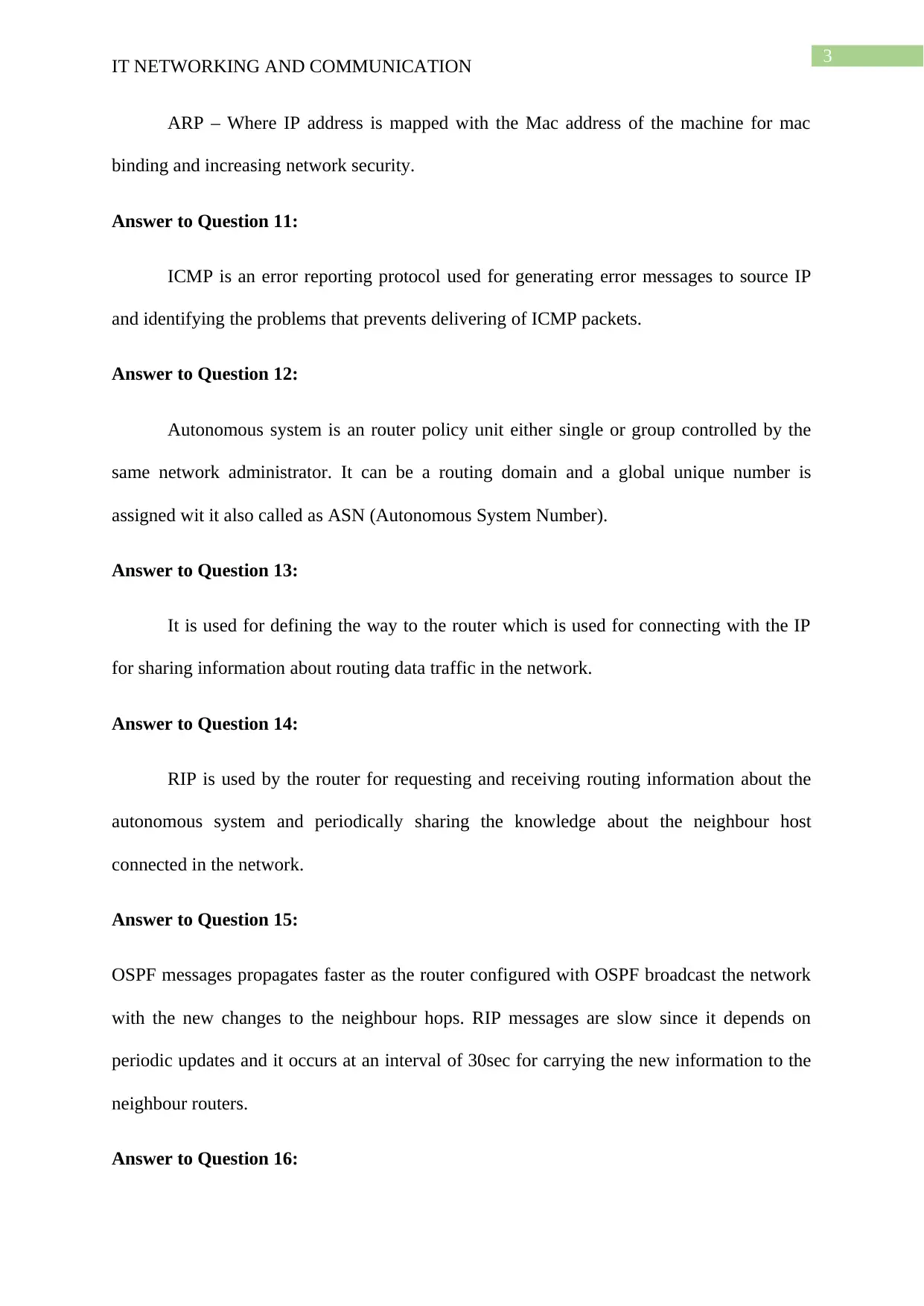
3
IT NETWORKING AND COMMUNICATION
ARP – Where IP address is mapped with the Mac address of the machine for mac
binding and increasing network security.
Answer to Question 11:
ICMP is an error reporting protocol used for generating error messages to source IP
and identifying the problems that prevents delivering of ICMP packets.
Answer to Question 12:
Autonomous system is an router policy unit either single or group controlled by the
same network administrator. It can be a routing domain and a global unique number is
assigned wit it also called as ASN (Autonomous System Number).
Answer to Question 13:
It is used for defining the way to the router which is used for connecting with the IP
for sharing information about routing data traffic in the network.
Answer to Question 14:
RIP is used by the router for requesting and receiving routing information about the
autonomous system and periodically sharing the knowledge about the neighbour host
connected in the network.
Answer to Question 15:
OSPF messages propagates faster as the router configured with OSPF broadcast the network
with the new changes to the neighbour hops. RIP messages are slow since it depends on
periodic updates and it occurs at an interval of 30sec for carrying the new information to the
neighbour routers.
Answer to Question 16:
IT NETWORKING AND COMMUNICATION
ARP – Where IP address is mapped with the Mac address of the machine for mac
binding and increasing network security.
Answer to Question 11:
ICMP is an error reporting protocol used for generating error messages to source IP
and identifying the problems that prevents delivering of ICMP packets.
Answer to Question 12:
Autonomous system is an router policy unit either single or group controlled by the
same network administrator. It can be a routing domain and a global unique number is
assigned wit it also called as ASN (Autonomous System Number).
Answer to Question 13:
It is used for defining the way to the router which is used for connecting with the IP
for sharing information about routing data traffic in the network.
Answer to Question 14:
RIP is used by the router for requesting and receiving routing information about the
autonomous system and periodically sharing the knowledge about the neighbour host
connected in the network.
Answer to Question 15:
OSPF messages propagates faster as the router configured with OSPF broadcast the network
with the new changes to the neighbour hops. RIP messages are slow since it depends on
periodic updates and it occurs at an interval of 30sec for carrying the new information to the
neighbour routers.
Answer to Question 16:
Paraphrase This Document
Need a fresh take? Get an instant paraphrase of this document with our AI Paraphraser

4
IT NETWORKING AND COMMUNICATION
The main purpose of BGP is to establish interdomain routing following the path
vector routing principles.
Answer to Question 17:
Distance vector routing the information about the entire autonomous system is shared
whereas in link state routing the information about the neighbour routers are shared in the
autonomous system.
IT NETWORKING AND COMMUNICATION
The main purpose of BGP is to establish interdomain routing following the path
vector routing principles.
Answer to Question 17:
Distance vector routing the information about the entire autonomous system is shared
whereas in link state routing the information about the neighbour routers are shared in the
autonomous system.
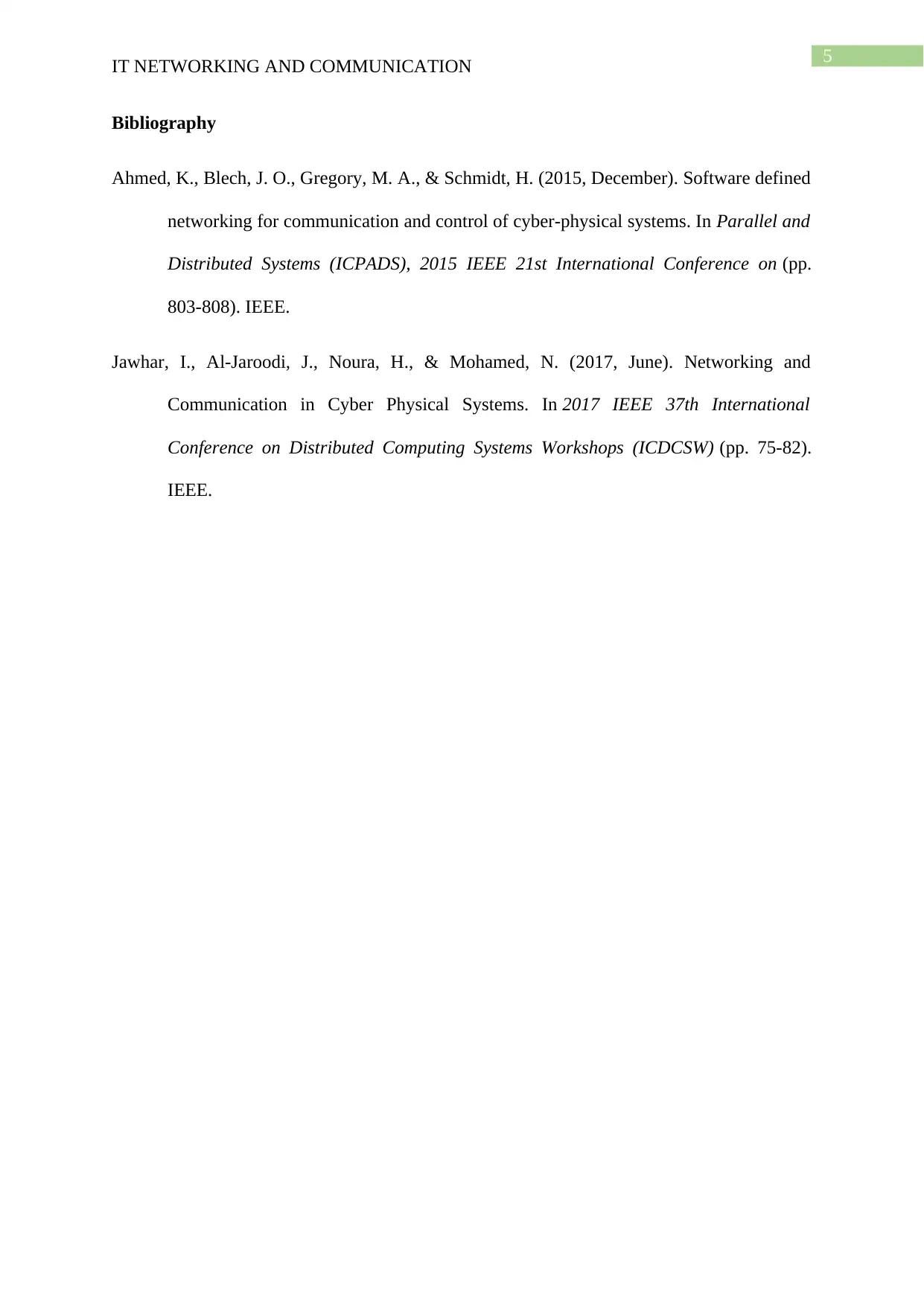
5
IT NETWORKING AND COMMUNICATION
Bibliography
Ahmed, K., Blech, J. O., Gregory, M. A., & Schmidt, H. (2015, December). Software defined
networking for communication and control of cyber-physical systems. In Parallel and
Distributed Systems (ICPADS), 2015 IEEE 21st International Conference on (pp.
803-808). IEEE.
Jawhar, I., Al-Jaroodi, J., Noura, H., & Mohamed, N. (2017, June). Networking and
Communication in Cyber Physical Systems. In 2017 IEEE 37th International
Conference on Distributed Computing Systems Workshops (ICDCSW) (pp. 75-82).
IEEE.
IT NETWORKING AND COMMUNICATION
Bibliography
Ahmed, K., Blech, J. O., Gregory, M. A., & Schmidt, H. (2015, December). Software defined
networking for communication and control of cyber-physical systems. In Parallel and
Distributed Systems (ICPADS), 2015 IEEE 21st International Conference on (pp.
803-808). IEEE.
Jawhar, I., Al-Jaroodi, J., Noura, H., & Mohamed, N. (2017, June). Networking and
Communication in Cyber Physical Systems. In 2017 IEEE 37th International
Conference on Distributed Computing Systems Workshops (ICDCSW) (pp. 75-82).
IEEE.
⊘ This is a preview!⊘
Do you want full access?
Subscribe today to unlock all pages.

Trusted by 1+ million students worldwide
1 out of 6
Related Documents
Your All-in-One AI-Powered Toolkit for Academic Success.
+13062052269
info@desklib.com
Available 24*7 on WhatsApp / Email
![[object Object]](/_next/static/media/star-bottom.7253800d.svg)
Unlock your academic potential
Copyright © 2020–2025 A2Z Services. All Rights Reserved. Developed and managed by ZUCOL.





